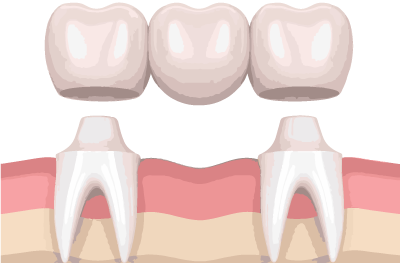How are dental bridges fitted?
After determining with your dentist that a dental bridge is the best solution to replace your missing teeth your dentist will take an impression of your mouth for the bridge.
This involves creating a mould of your teeth and gum so the bridge can be created to fit your mouth as close as possible.
Your dentist may also be able to help you choose the best color for your new tooth replacement.
After the bridge has been made, it must be checked for accuracy before it is sent back to the laboratory. You may need to wear a temporary fix until your custom bridge arrives.

Your dentist will then put your new bridge into place at your next visit. Before the procedure starts, you'll receive an injection that blocks any pain from your gingival tissues; however, you won't fall asleep during the procedure. You'll be checked for a proper bite before the fitting begins so that the new bridge fits comfortably.
You may then need to return for a third visit which will allow your dentist to check the bridge and make any adjustments in case you are experiencing any discomfort or pain.
What happens after your bridge has been fitted?
After placing a dental crown, there may be some sensitivity to hot and/ or cold foods and beverages. This is normal. Your new tooth may be feeling a bit different than before because it's filling up the space left by your old one. These issues usually resolve after a few days. Sometimes, new teeth can feel slightly high when they come into place. You may need to visit your dentist to correct minor problems like these in follow-up appointments
Bridges are permanently fixed, so you don't need to remove them for cleaning. To keep your natural teeth healthy, you will need to make sure you clean the gap under a bridge with a special dental floss. Your dentist or hygienist will show you how and where to floss under your bridge. If it is well cared for, a bridge can last many years.
Why do I need a dental bridge?
Dental bridges can be used to replace missing teeth or teeth. The most common causes for missing teeth are tooth decay, gum disease or an injury that causes loose teeth or tooth loss. Or you may have had missing teeth due to a congenital condition. To be able to have a dental bridge, you will need healthy teeth on either side of the missing ones.
Your teeth work together so if one tooth is missing, nearby ones can move into the empty spot. Your teeth in your opposite jaw can also move up or downward toward the space. This can cause problems with your other teeth and chewing. It can also cause discomfort from the extra stress on the teeth and jaw as well the self-consciousness about how you look or your smile

What types of dental bridges are available?
-
Traditional fixed bridge
The most common type of bridge. It has two or three crowns and a filer tooth or teeth that are connected. The crowns keep your bridge in place. Traditional bridges are made out of metal, ceramics, or porcelain fused with metal.
-
Cantilever Bridges
Cantilever bridges have some similarities to traditional bridges. They are made of porcelain fused with metal. To support a cantilever bridge, you must have at least one natural tooth remaining next to the missing tooth.
A cantilever dental bridge is a dental crown (artificially-made tooth) placed over the unhealthy tooth.
This type of bridge can be used to restore front teeth. Cantilever bridges are not strong enough to support molar teeth (back teeth).
-
Maryland Bridges
Maryland bridges are less invasive than traditional bridges. They have a pontic (fake tooth) that's supported by a metal framework, and are made of porcelain This material is nearly as white as your natural teeth.
A Maryland Bridge is used to restore your front teeth (incisors . They are rarely used for the restoration of missing canines or molars. This is because canines are very important to the strength of your bite and Maryland bridges can loosen or move easily.
-
Implant-Supported Bridges
This bridge is similar in design to a “traditional bridge” but instead is held in place by dental implants rather than being cemented in.
Implant-supported bridge bridges are supported entirely by implants, instead of a framework or dental crowns This type of bridge replaces the teeth that are missing. Implant bridges are best for patients who have at least three missing molars in row.
Dental Implants, frequently asked quesitons.
What can be used instead of a dental bridge?
Some people choose removable false teeth, which are called partial dentures. You take them out and clean them. You may also be considered for a dental implant. An implant is surgically placed in your jaw to replace missing teeth. Your dentist can help figure out what the best option is for you.

